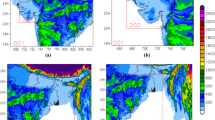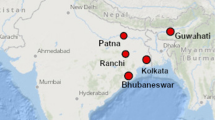Abstract
Thunderstorms are the perennial feature of Kolkata (22° 32′ N, 88° 20′ E), India during the premonsoon season (April–May). Precise forecast of these thunderstorms is essential to mitigate the associated catastrophe due to lightning flashes, strong wind gusts, torrential rain, and occasional hail and tornadoes. The present research provides a composite stability index for forecasting thunderstorms. The forecast quality detection parameters are computed with the available indices during the period from 1997 to 2006 to select the most relevant indices with threshold ranges for the prevalence of such thunderstorms. The analyses reveal that the lifted index (LI) within the range of −5 to −12 °C, convective inhibition energy (CIN) within the range of 0–150 J/kg and convective available potential energy (CAPE) within the ranges of 2,000 to 7,000 J/kg are the most pertinent indices for the prevalence thunderstorms over Kolkata during the premonsoon season. A composite stability index, thunderstorm prediction index (TPI) is formulated with LI, CIN, and CAPE. The statistical skill score analyses show that the accuracy in forecasting such thunderstorms with TPI is 99.67 % with lead time less than 12 h during training the index whereas the accuracies are 89.64 % with LI, 60 % with CIN and 49.8 % with CAPE. The performance diagram supports that TPI has better forecast skill than its individual components. The forecast with TPI is validated with the observation of the India Meteorological Department during the period from 2007 to 2009. The real-time forecast of thunderstorms with TPI is provided for the year 2010.



















Similar content being viewed by others
References
Abraham A, Philip NS, Joseph B (2001) Will we have a wet summer? Long-term rain forecasting using Soft Computing models. In: Kerchoffs EJH & Snorek M (eds) Modeling and simulation 2001. Society for Computer Simulation International: Prague, Czech Republic. pp 1044–1048
Anderson T, Anderson M, Jacobson C, Nilsson S (1989) Thermodynamic indices for forecasting thunderstorms in southern Sweden. Meteor Mag 118:141–146
Anthes RA (1976) Numerical prediction of severe storms—certainty, probability, or dream. Bull Amer Met Soc 57:423–430
Chaudhuri S (2007) Chaotic graph theory approach for identification of convective available potential energy (CAPE) patterns required for the genesis of severe thunderstorm. Adv Complex Syst 10:413–422
Chaudhuri S (2008) Preferred type of cloud in the genesis of severe thunderstorms—a soft computing approach. Atmos Res 88:149–156
Chaudhuri S, Middey A (2009) Applicability of bipartite graph model for thunderstorms forecast over Kolkata. Adv Meteorol 2009:1–12
Chaudhuri S (2010a) Convective energies in forecasting severe thunderstorms with one hidden layer neural net and variable learning rate back propagation algorithm. Asia Pacific J Atmos Sci 46(2):173–183
Chaudhuri S (2010b) Predictability of severe thunderstorms with fractal dimension approach. Asian J Water Air Environ Pollut 7(4):81–87
Chaudhuri S (2011a) Implementation of intuitionistic fuzzy logic to assess the predictability of Severe thunderstorms. Asia-Pacific J Atmos Sci 47(5):477–483
Chaudhuri S (2011b) A probe for consistency in CAPE and CINE during the prevalence of severe thunderstorms: statistical-fuzzy coupled approach. Atmos Clim Sci 4(1):197–205
Chaudhuri S, Middey A (2011a) Nowcasting thunderstorms with graph spectral distance and entropy estimation. Meteorol Appl Vol 18(2):238–249
Chaudhuri S, Middey A (2011b) Adaptive neuro-fuzzy inference system to forecast peak gust speed during thunderstorms. Meteorol Atmos Phys 114:139–149
Chaudhuri S, Anirban M, Sayantika G, Soumita B (2012) Appraisal of the prevalence of severe tropical storms over Indian Ocean by screening the features of tropical depressions. Nat Hazards 61(2):745–756
Doswell CA (1987) The distinction between large-scale and mesoscale contribution to severe convection: a case study example. Wea Forecast 2:3–16
Elshorbagy A, Simonovic SP, Panu US (2000) Performance evaluation of artificial neural networks for runoff prediction. J Hydrol Eng ASCE 5(4):424–427
Fernando DAK, Jayawardena AW (1998) Runoff forecasting using RBF networks with OLS algorithm. J Hydrol Eng 3(3):203–209
Hsieh WW, Tang T (1998) Applying neural network models to prediction and data analysis in meteorology and oceanography. Bull Am Meteorol Soc 79:1855–1869
Huntrieser H, Schiesser HH, Schmid W, Waldvogel A (1997) Comparison of traditional and newly developed thunderstorm indices for Switzerland. Wea Forecast 12:108–125
IMD (1941) Nor’westers of Bengal, India Meteorological Department. Tech Note No. 10
Jacovides CP, Yonetani T (1990) An evaluation of stability indices for thunderstorm prediction in Greater Cyprus. Weather Forecast 5(4):559–569
Jin L, Yao C, Huang YX (2008) A nonlinear artificial intelligence ensemble prediction model for typhoon intensity. Mon Weather Rev 136:4541–4554
Johns RH, Doswell CA III (1992) Severe local storms forecasting. Wea Forecast 7:588–612
Jolliffe IT, Stephenson DB (2003) Forecast verification: a practitioner's guide in atmospheric science. Wiley, Chichester. ISBN 0-471-49759-2
Lal R (1990) Forecasting of severe convective activity over Lucknow in premonsoon season. Mausam 41:455–458
Lee RR, Passner JE (1993) The development and verification of TIPS: an expert system to forecast thunderstorm occurrence. Wea Forecast 8:271–280
Lilly DK (1990) Numerical prediction of thunderstorms—has its time come? Quart J Roy Meteor Soc 116:779–798
Marzban C, Stumpf G (1998) A neural network for damaging wind prediction. Weather Forecast 13:151–163
Marzban C, Witt A (2001) A Bayesian neural network for severe hail size prediction. Weather Forecast 16:600–610
McCann DW (1992) A neural network short-term forecast of significant thunderstorms. Weather Forecast 7:525–534
Neumann CJ (1971) The thunderstorm forecasting system at the Kennedy Space Center. J Appl Meteorol 10:921–936
Orlanski I (1975) A rational subdivision of scales for atmospheric processes. Bull Am Meteorol Soc 56(5):527–530
Pawlak Z, Skowron (2007) Rough sets and Boolean reasoning. Inf Sci 177(1):41–73
Pepple RA, Lamb PJ (1989) Tropospheric static stability and North American growing season rainfall. Mon Wea Rev 117:1156–1180
Rajurkar MP, Kothyari UC, Chaube UC (2004) Modeling of the daily rainfall–runoff relationship with artificial neural network. J Hydrol 285(1–4):96–113
Rasmussen EN, Blanchard DO (1998) A baseline climatology of sounding-derived supercell and tornado forecast parameters. Wea Forecast 13:1148–1164
Ravi N, Mohanty UC, Madan OP, Paliwal RK (1999) Forecasting of thunderstorms in the pre monsoon season at Delhi. Met Appl 6:29–38
Reap RM, Foster DS (1979) Automated 12–36 hour probability forecasts of thunderstorms and severe local storms. J Appl Meteor 18:1304–1315
Riemann-Campe K, Blender R, Fraedrich K (2010) Global memory analysis in observed and simulated CAPE and CIN. Int J Climatol 31:1099–1107
Roebber P (2009) Visualizing multiple measures of forecast quality. Weather Forecast 24:601–608
Schultz P (1989) Relationship of several stability indices to convective weather events in Northest Colorado. Wea Forecast 4:73–80
Stone HM (1985) A comparison among various thermodynamic parameters for the prediction of convective activity, Part I, NOAA Technical Memorandum, NWS-ER 68, Washington D C
Tokar AS, Markus M (2000) Precipitation–runoff modeling using artificial neural networks and conceptual models. J Hydrol Eng 5(2):156–161
Trafalis TB, Richman MB, Santosa B (2006) Learning networks for tornado detection. Int J Gen Syst 35:93–107
Tyagi B, Krishna NV, Satyanarayana ANV (2011) Study of thermodynamic indices in forecasting pre-monsoon thunderstorms over Kolkata during STORM pilot phase 2006–2008. Nat Hazard 56:681–698
Wang Y, Yu TY, Yeary M, Shapiro A, Nemati S, Foster M, Andra DL Jr, Jain M (2008) Tornado detection using a neuro-fuzzy system to integrate shear and spectral signatures. J Atmos Ocean Technol 25(7):1136–1148
Zhao Q, Cook J, Xu Q, Harasti PR (2008) Improving short-term storm predictions by assimilating both radar radial-wind and reflectivity observations. Weather Forecast 23(3):373–391
Acknowledgments
The first author gratefully acknowledges Indian Meteorological Department (IMD) and Department of Atmospheric Sciences, University of Wyoming (http://www.weather.uwyo.edu) for providing the data archives. The financial support rendered by CSIR is acknowledged. The authors express special gratitude to the anonymous reviewers for their substantial remarks that increased the completeness and clarity of the manuscript.
Author information
Authors and Affiliations
Corresponding author
Rights and permissions
About this article
Cite this article
Chaudhuri, S., Middey, A. A composite stability index for dichotomous forecast of thunderstorms. Theor Appl Climatol 110, 457–469 (2012). https://doi.org/10.1007/s00704-012-0640-z
Received:
Accepted:
Published:
Issue Date:
DOI: https://doi.org/10.1007/s00704-012-0640-z




